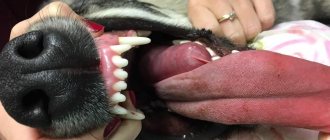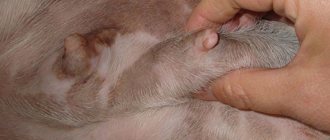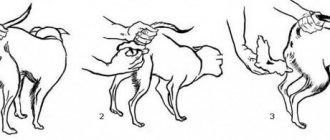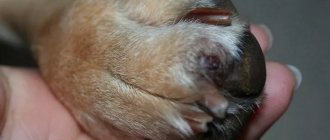4329Pavel
Every veterinarian knows how to treat a fistula in a cat, but for the owner such a health problem in a pet poses great difficulties. A fistula is a canal that connects an internal organ (mostly hollow) with the external environment. A canal that connects two cavities is also called a fistula. Such channels are not natural, but pathological, arising against the background of various diseases. The inner surface of the fistula can be lined with epithelial or wound tissue. Outwardly, it most often looks like a freshly opened abscess on a cat.
Often, confusing a fistula with an abscess, owners begin to self-medicate the cat, which ultimately only aggravates the condition of the sick animal. In severe cases, improper treatment and refusal to seek help from veterinarians lead to the death of the cat. The main complication that occurs against the background of a fistula is sepsis. If the blood is infected, it is almost impossible to save an animal even in the conditions of the most modern veterinary clinic.
© shutterstock
At the slightest suspicion of the presence of a pathological phenomenon, you should urgently show your pet to a veterinarian. Only a specialist can carry out the correct treatment and restore the cat’s health.
Congenital and acquired fistulas
In order to understand how to treat fistulas in a cat, you need to be able to recognize them. The congenital type of the disease is the presence of a channel from the body cavities to the outside. Most often in kittens, such a canal comes from the abdominal cavity.
Of course, the congenital defect itself does not pose any harm to health, but due to the fact that it opens access to internal cavities, a virus can get there.
This deviation occurs if the mother cat was sick while carrying kittens and her immune system was weakened.
Acquired fistulas are a serious pathology that can lead to the death of a pet. They have a slightly different structure from the congenital ones.
If the canal of a congenital fistula consists of healthy tissue, then the tissue here is hyperemic, that is, painful.
Such fistulas can occur as a result of penetrating wounds with infection of surrounding tissues. Another reason is injury from bone fragments during fractures. The second option heals on its own and does not require any intervention.
Fistulas can also occur after operations. Such varieties indicate an incorrect operation process and a violation of the aseptic regime.
A fistula in a cat under the tail can appear due to improper castration. Pus accumulates and seeks a way out, creating ducts on its own in the form of fistulas.
Another option for the occurrence of a pathological fistula is home treatment for dangerous inflammatory processes.Visiting a veterinary clinic
Umbilical hernia on a kitten's stomach: what to do
If you find any through wound, do not delay visiting the veterinarian. To diagnose a disease, a doctor must:
- examine the animal;
- collect a blood test (general and biochemical);
- conduct ultrasound and magnetic resonance imaging.
Note! The formation of a fistula often indicates the onset of cancer. In this case, an additional biopsy is prescribed.
After therapeutic studies have been carried out, treatment of the animal is prescribed. It can be done either conservatively or through surgical intervention. The first method eliminates only granulating fistulas and the causes that caused them. In any other case, surgery will be required.
Treatment takes place in several stages:
- Elimination of the source of inflammation and surrounding dead tissue cells.
- Installation of drainage to drain fluid through it.
- Cleansing the fistula, removing tissue debris and waste products.
- Treatment of the canal with disinfectants.
- Regular rinsing of the canal with the accompanying application of a bandage with antiseptic and wound-healing ointments.
- Prescription of antibiotics and immunostimulating agents.
For your information! In more severe cases, when the fistula is old and difficult to heal, it is sutured in a special way for rapid healing.
When treating an epithelialized fistula, it is necessary to remove the source of pus and dead tissue in the canal. When treating labiform fistulas, it is necessary to restore the anatomical structure and functions of the affected organ.
Removal of a fistula is almost always performed only surgically
Symptoms and diagnosis of the disease
The external fistula looks like a funnel from the internal cavity. Depending on where the fistula is located on the internal organ, different contents are released from it.
This hole does not close on its own. Liquid constantly leaks out of it and the fur around the area becomes crusty and sticks together.
Another noticeable symptom of a fistula in a cat is an unpleasant odor that comes from the site of the injury. If you have these symptoms, you should immediately contact a specialist. The most difficult type of fistula in a cat is paraanal.
Seizures in cats - main causes, symptoms, first aid, treatment and choice of drugs (110 photos)Polycystic kidney disease in cats - causes, diagnosis and symptoms of the disease. Treatment options and prevention of kidney disease (95 photos)
Tartar in cats - signs of the disease and methods of fully treating tartar (125 photos + video)
A doctor can easily diagnose a cat's fistula in the abdomen and other areas with the help of additional tests. This will most likely include an external examination, collection of tests, and ultrasound.
If a fistula is found on the cat's back, then this is most likely an indicator of a tumor and a biopsy is necessary.
An internal fistula cannot be recognized by external symptoms, since they appear only in severe stages. In this case, treatment may not have any effect.Symptoms of the disease
In order to be fully prepared and not to miss the moment of the onset of your pet’s illness, you need to know the following symptoms and characteristics of the animal’s behavior when sick.
Stage 1
The dog is worried. Always tries to scratch or bite the area under the tail. The pet constantly tries to ride on its butt to scratch this area or get rid of discomfort by licking under the tail.
Be careful and examine what is going on with your pet. The secret is little revealed at this stage. Its color ranges from transparent to yellowish.
Often the owner thinks that his four-legged friend has worms and carries out deworming. But therapy will not help if such behavior is not caused by parasites.
Stage 2
The secretion becomes noticeably thicker, its quantity is even smaller. New signs of the disease appear - hair falls out on the tail and at its base, and pustules and vesicles (rash) appear on the skin of the inner thighs.
The dog will experience stiffness in the movements of its hind legs. At this time, the secretion is actively absorbed into the blood, and the animal begins to lick the skin.
Stage 3
The secretory fluid takes on a creamy consistency, its quantity decreases sharply, and the color becomes even darker. The dog itches more and more, the itching intensifies, and a neurological syndrome occurs.
At this time, contamination with pathogenic and putrefactive bacteria continues, the entire gland and nearby tissues become inflamed.
Stage 4
The secretion turns into a clay-like, granular substance. Color ranges from dark brown to black. The part of the body below the waist can be paralyzing.
Instructions for use
Photo of a fistula in a cat
Ringworm in cats - main signs, symptoms, prevention and treatment of ringworm in cats (105 photos)Pancreatitis in cats: first symptoms, nutritional nuances and treatment options (125 photos and videos)
Subcutaneous mites in cats - first symptoms, treatment options and real photos of examples of parasite damage (110 photos + video)
https://www.youtube.com/watch?v=I0vJiLXL3b
Read here Ulcer in a cat: symptoms, treatment, diagnosis and diet after surgery (145 photos and videos)
Help the site, share with friends 
Reasons for appearance
In most cases, the cause of fistulas is improper treatment of skin diseases, such as a boil or abscess. Pathological holes also form due to injury or as a consequence of surgical interventions, especially often after sterilization. The fistula affects the cheeks in advanced forms of periodontal disease or caries. Paraproctitis in a cat leads to the development of a canal under the tail near the anus.
The operation to eliminate the pathological canal must be performed in a sterile environment to prevent the penetration of another infection.
How to treat?
Treatment of a fistula at home will not bring a positive result, since it can only be cured surgically under sterile conditions. Surgical intervention is carried out in stages in the following order:
During surgery, a drainage tube is installed in the animal.
- Having cut the wound and reached the place where it originates, the surgeon cuts out dead tissue with a scalpel. The inflamed area is removed completely to prevent relapse.
- A drain is placed near the fistula to allow fluid to flow through it.
- The doctor cleans the canal and rinses it with antibacterial solutions.
- Every day the fistula is washed and bandages are applied with antibiotic ointments. If the hole has existed for a long time, then the canal is sutured for effective healing.
Veterinarians recommend doing a biopsy on the animal for diagnostic purposes, since a pathological fistula on the back may indicate an oncological tumor.
Paraanal sinusitis
This is the medical term for inflammation of the paraanal glands . Inflammation can be on only one side or on both. The glands become inflamed when they become infected. Usually these are different types of staphylococci and E. coli.
Paraanal sinusitis is often accompanied by phlegmon. This is the name for the diffuse presence of pus in the tissues of the subcutaneous tissue.
However, a dog of any breed and at any age can get sick. More often, the glands become inflamed in dogs with a sedentary lifestyle. This is due to the fact that inactive dogs have reduced muscle tone. The muscles that empty the sinuses of secretions are also weakened.
A genetic predisposition to sinusitis and gland abscesses has been identified. The development of the disease is also influenced by improper feeding and infestation.
When the anal glands become inflamed, the dog begins to roll its butt on the floor or frequently lick under its tail. There are problems with stool, refusal to sit on the butt, aggression when examining the painful area.
How to warn?
To prevent the formation of fistulas, it is necessary to regularly take the animal to a veterinarian. At the initial stage, the disease can be easily and effectively cured. If a wound forms on the back, stomach or other area of the body, you need to ensure that it heals well. And when bones are fractured, their proper healing is very important. Cat food must be fortified, of high quality and balanced, and antiparasitic therapy must be carried out in a timely manner. Strong protective properties of the body are the key to the health of a pet.











